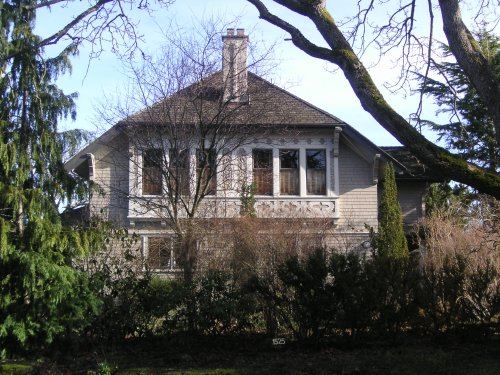1525 Prospect Place


The C. Dubois Mason House is a two-storey Tudor Revival style residence, with a full basement, located on a bend in the road along picturesque Prospect Place. The main façade has an exaggerated jerkin-headed roof over a double bay which is decorated with elaborate strapwork and roughcast stucco.
Built in 1908, the heritage value of the C. Dubois Mason house is as part of the first planned subdivision in Oak Bay, and illustrates one of the ways in which Oak Bay developed in the early years. After incorporation, in 1906, the Municipality evolved from a recreational and agricultural area to a residential community. In 1898 architects Francis Rattenbury and John G. Tiarks, recognizing the potential value of the Oak Bay waterfront, purchased land extending from Oak Bay Avenue eastward to present-day San Carlos Avenue, property that would become part of Oak Bay. The parcel of land was acquired from the estate of the late Joseph Despard Pemberton, former Surveyor General of the Colony of Vancouver Island. Over the next few years the partners began development in the area and influenced construction of quality homes on adjacent land, including 1525 Prospect Place, and Rattenbury’s own residence, ‘Iechinihl’ (1899), located nearby on Beach Drive and now the primary location for Glenlyon Norfolk School.
This site makes an important contribution to the ambiance and streetscape of Prospect Place which is a winding lane with no sidewalks that has the appearance of being in the country even though it is only one block away from busy Beach Drive.
The C. Dubois Mason House is important for its association with Francis Mawson Rattenbury (1867-1935) - one of British Columbia’s most prominent early architects. He arrived in BC in 1892 and within a month won the international design competition for the new Parliament Buildings. He was a member of the first council of the Municipality of Oak Bay, for which he designed the original municipal crest. His successful campaign for Reeve of Oak Bay called for the preservation of the natural environment, and on the insistence that quality and beauty should be hallmarks of the built environment.
The C. Dubois Mason house is a fine example of British Arts and Crafts architecture, with Tudor Revival detailing,; an iconic style for Oak Bay. Elements such as the rich wood strapwork, combined with roughcast stucco, on the main fa_ade; the prominent ornamented stuccoed chimney; and the heavy eaves brackets are all characteristics of the style. And the plan and siting of the house to take advantage of the views across the Strait towards Mount Baker are indicative of the architect's desire to follow the Arts and Crafts principle of harmonizing the house and the site. The interior is almost entirely original and demonstrates the Arts and Crafts ideals of fitness for purpose and truth to materials.
- residential setback, with views to Mt. Baker, built on a rocky slope
- location as part of Prospect Place heritage cluster
- form, scale and massing
- exaggerated jerkin-headed roof
- wood frame construction and concrete foundation
- style details such as: façade detail with shingles and strapwork, heavy eaves brackets, large overhang on porch, double-width square bay on second storey
- exterior architectural elements such as: two chimneys, large verandah that stretches full length of back of house on principal floor with porch above
- fenestration, and window types such as: double-hung single sash in single- and multiple-assembly, multi-paned casement
- original interior features such as: woodwork, glass, door hardware, and decorative scroll-work
- landscape features: stone wall, stone piers, mature coniferous and deciduous trees
 Instagram
Instagram
 Facebook
Facebook
 Twitter
Follow @DistrictOakBay
Twitter
Follow @DistrictOakBay